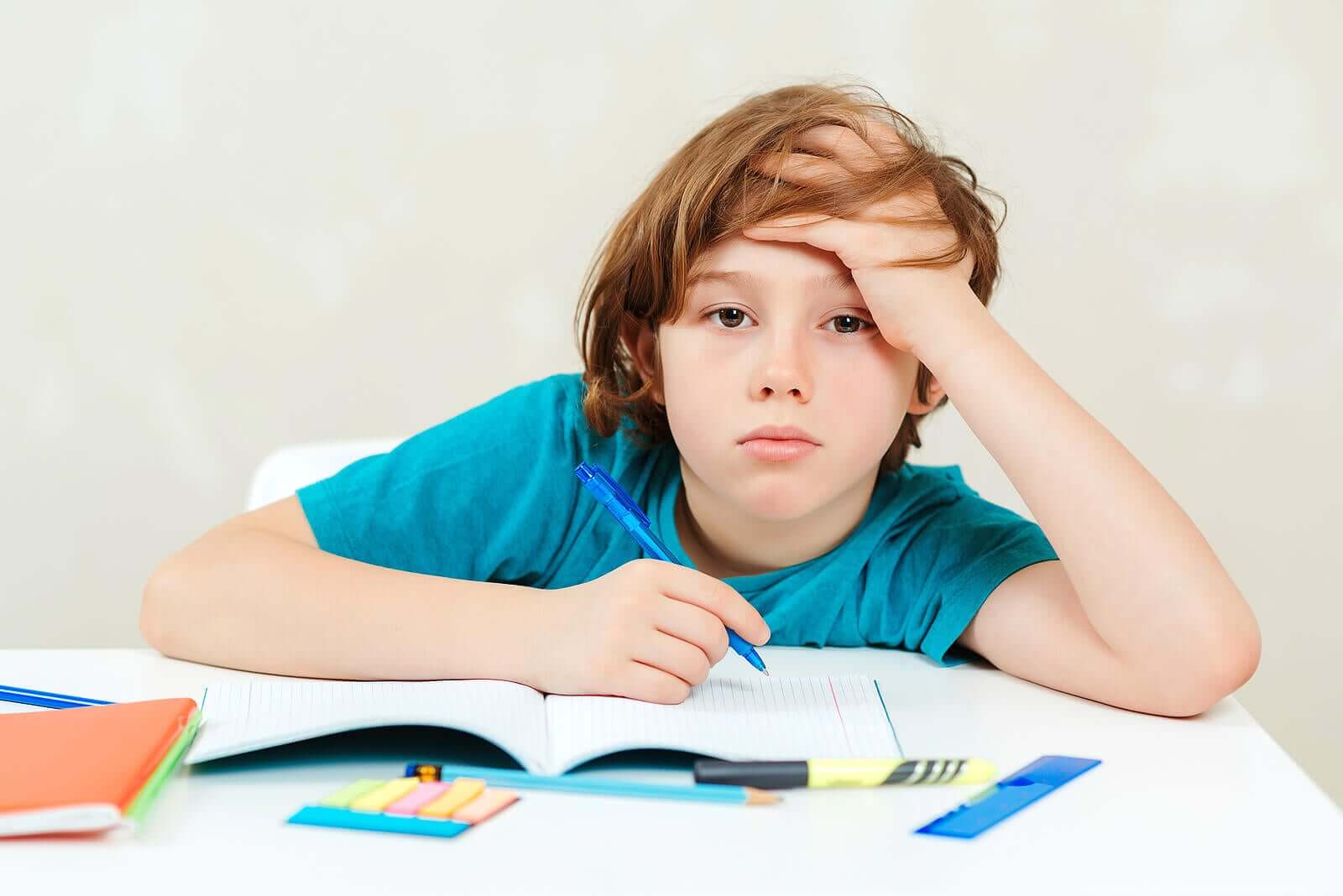Learning Difficulties in Children: Strategies to Help Them at Home


Written and verified by the psychopedagogue María José Roldán
Imagine that you’re sitting at the table helping your children with their homework. You’re doing your best to keep them focused, but even sharpening a pencil can make their concentration go away. That might be a case of learning difficulties in children and you should do something about it. Here you’ll find some strategies, adapted to their real capacities, to help them at home.
You might think that doing homework with children with learning difficulties is complicated, however, you’ll find it quite easy once you learn these strategies.
Learning difficulties in children: strategies to help them at home

Teamwork
First, you should get in touch with your children’s teacher to talk about their habits when doing homework. Tell them how long it takes them to do their homework and how much they get distracted when they’re supposed to be concentrated. This way, you’ll also learn the teacher’s expectations regarding your children’s intellectual development.
In the same way, it’ll be important that you make a homework plan to help them solve the problems they may encounter at home. Make them understand that it’s teamwork. And, even if you and the teacher are by their side, they have to put their effort in order to improve their own learning development.
Enjoyable 5-minute breaks
When children get frustrated with a particular task, it’s best to take a five-minute break to do something fun. Yo can walk around, listen to music or have a snack. This can help them end their frustration so they can go back to doing their homework with a new perspective.
As a result, they’ll go back with renewed energy and a willingness to make things better. If you keep them sitting for a long time, frustrated and doing the same thing over and over (with no results), you might be contributing to an emotional blockage. This is why a fun five-minute break is so important.
Homework completion board
Together you can make a homework completion board and put it on the fridge or wherever your children can see it. You can make it on your own or download it from the internet.
Then, you should mark with an “X” every time your children complete a task. Furthermore, you can reward your children whenever they complete the whole board. The important thing here is that you appreciate your children’s achievements the way you think it’s best.
Shared reading, one of the best strategies for children with learning difficulties
Reading a whole chapter from a book can be overwhelming for children with learning difficulties. However, you can help them to prevent the stress that this can cause them. It’s important to help them learn to love reading and understand the value of doing it.

To do this, you can let your children read the first paragraph or phrase of a book and, if they’re new readers, you can read most of the text and leave them small parts of it. This way, the information from the text will be more interesting.
In addition, it’s important to pause to strengthen the concepts that they’re acquiring. This will help your children keep focusing and committing to the tasks they’re supposed to complete.
Listening to soft music
There’s nothing negative about listening to soft music while doing homework, even if your children have learning difficulties. If you choose the right music, it doesn’t have to be a distraction. It should be melodic and your children shouldn’t understand the lyrics.
By doing this, children will feel that homework is a more pleasant thing to do, and what’s more, they’ll enjoy the music. Furthermore, if you play any instruments, playing soft music while your children are studying might block annoying noises. If the music distracts other members of the family, your children can use headphones.
Finally, we hope that these strategies will help you at home when you have to choose the best alternatives for your children with learning difficulties.
Imagine that you’re sitting at the table helping your children with their homework. You’re doing your best to keep them focused, but even sharpening a pencil can make their concentration go away. That might be a case of learning difficulties in children and you should do something about it. Here you’ll find some strategies, adapted to their real capacities, to help them at home.
You might think that doing homework with children with learning difficulties is complicated, however, you’ll find it quite easy once you learn these strategies.
Learning difficulties in children: strategies to help them at home

Teamwork
First, you should get in touch with your children’s teacher to talk about their habits when doing homework. Tell them how long it takes them to do their homework and how much they get distracted when they’re supposed to be concentrated. This way, you’ll also learn the teacher’s expectations regarding your children’s intellectual development.
In the same way, it’ll be important that you make a homework plan to help them solve the problems they may encounter at home. Make them understand that it’s teamwork. And, even if you and the teacher are by their side, they have to put their effort in order to improve their own learning development.
Enjoyable 5-minute breaks
When children get frustrated with a particular task, it’s best to take a five-minute break to do something fun. Yo can walk around, listen to music or have a snack. This can help them end their frustration so they can go back to doing their homework with a new perspective.
As a result, they’ll go back with renewed energy and a willingness to make things better. If you keep them sitting for a long time, frustrated and doing the same thing over and over (with no results), you might be contributing to an emotional blockage. This is why a fun five-minute break is so important.
Homework completion board
Together you can make a homework completion board and put it on the fridge or wherever your children can see it. You can make it on your own or download it from the internet.
Then, you should mark with an “X” every time your children complete a task. Furthermore, you can reward your children whenever they complete the whole board. The important thing here is that you appreciate your children’s achievements the way you think it’s best.
Shared reading, one of the best strategies for children with learning difficulties
Reading a whole chapter from a book can be overwhelming for children with learning difficulties. However, you can help them to prevent the stress that this can cause them. It’s important to help them learn to love reading and understand the value of doing it.

To do this, you can let your children read the first paragraph or phrase of a book and, if they’re new readers, you can read most of the text and leave them small parts of it. This way, the information from the text will be more interesting.
In addition, it’s important to pause to strengthen the concepts that they’re acquiring. This will help your children keep focusing and committing to the tasks they’re supposed to complete.
Listening to soft music
There’s nothing negative about listening to soft music while doing homework, even if your children have learning difficulties. If you choose the right music, it doesn’t have to be a distraction. It should be melodic and your children shouldn’t understand the lyrics.
By doing this, children will feel that homework is a more pleasant thing to do, and what’s more, they’ll enjoy the music. Furthermore, if you play any instruments, playing soft music while your children are studying might block annoying noises. If the music distracts other members of the family, your children can use headphones.
Finally, we hope that these strategies will help you at home when you have to choose the best alternatives for your children with learning difficulties.
This text is provided for informational purposes only and does not replace consultation with a professional. If in doubt, consult your specialist.








